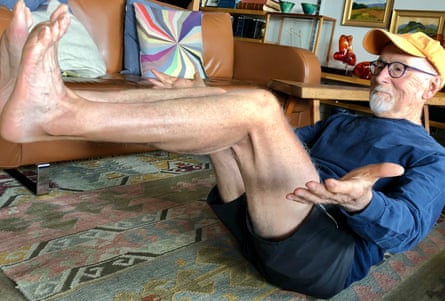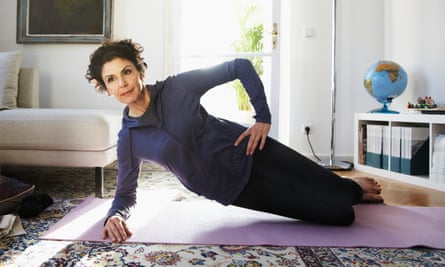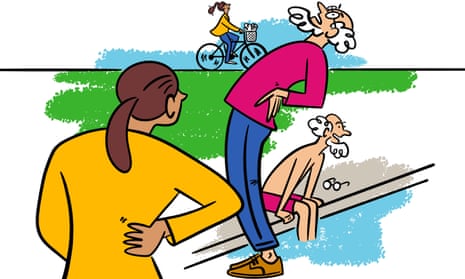Turns out pandemics can be atrocious for our backs. By last October, more than a third of people in the UK had reported increased back pain, according to one study – and that was before an intense winter lockdown, followed by a month-long storm. We’ve been doing online yoga without an instructor’s watchful eye and lunging with Joe Wicks without warming up, but mostly slouching over laptops feeling tense or depressed.
While the onset of back, shoulder or neck pain can feel like the last straw, the good news is that it probably isn’t as bad as you think. “It’s not likely to be serious,” says Chris Mercer, an NHS consultant physiotherapist in Sussex who specialises in back pain. It was not uncommon to keep an old door under the bed, upon which to lie when your back “went”. But the latest evidence indicates that being active is essential for both avoidance and recovery. “Keep moving, keep active and things will settle,” he says.
Embracing activity when you’re hurting can be scary, but Jack Noonan, an 80-year-old retired English professor who lives in Philadelphia, has learned the benefits first-hand. He did, in fact, have something serious – sciatica, intense pain, usually in the back of one leg, caused by the compression or irritation of the sciatic nerve – but is now as fit as a fiddle and believes the exercise regime he developed for himself not only cured his back pain, but helped him avoid surgery.

When he first developed sciatica he says he was “hit over the head with the pain”, adding that it was so bad at one point that he couldn’t even go for a walk. An orthopaedic surgeon told Noonan that he had a hardened perineural cyst in his spine, and the only lasting solution was surgery. But to Noonan, it felt “intuitive that if you can, by stretching, raise those collapsed vertebrae a little better, that might solve the problem. So I worked really, really hard. And it worked.”
A physiotherapist taught him how to do pelvic tilts – lying flat on your back and lifting the pelvis up off the floor. “It felt really good to learn how to move my pelvis,” he says, “and I became kind of driven about that.” He devised a series of 15 exercises – some from physiotherapists, some from yoga, some he has tweaked himself. He does them when he gets up, and again later in the day, each repeated 15 times, breathing through each one. “I’ve learned from experience that it’s easier to fake your way through 10,” he says. “But you want to be thoughtful and deliberate about every one of them.”
Noonan’s regime will not suit everyone but, crucially, he found what worked for him. Mercer’s good news continues, however, because it doesn’t matter what type of exercise you do, as long as you like it and you are sensible. “There is loads of evidence that exercise is good for back pain,” he says. “But none of the research points to one form of exercise being better than another. So the advice is to do something you enjoy because you’ll keep doing it. For me, that would be surfing or a bike ride, but for somebody else that could be doing Zumba, yoga or pilates. The evidence just says you’re better to move and do stuff than not. It’s a lot simpler than people think.”
Caroline Atkinson is living proof of such a philosophy. She is 55, 6ft 1in and has always been an athletic, mountain-climbing, sports-playing, distance-swimming kind of woman. In 1999, she had back surgery for disc degeneration, and is an advocate for exercising to manage ongoing back and shoulder problems, as well as an active member of the National Back Pain Association community.
“Within six months of the operation,” she says, “I was back in a pool. I’ve continued to have a gym membership. I started doing long-distance bike rides and hikes of 25 to 50 miles in one day.” She wanted to get back into tennis, too, but realised, “You don’t play tennis to get fit. You get fit so you can play the sport you love.” To do that, she started pilates, and continues a “regimental” daily routine. “Whether I’m in a hotel room or a tent or working in an office, I get my mat out and do pilates every morning to remobilise myself. If I didn’t do my stretching in the morning and I didn’t get up throughout the day, I would really suffer.”
While an entire industry has sprung up around the notion of special exercises for individual conditions, says Mercer, “the evidence doesn’t stack up behind them”. There has, for example, been great emphasis on improving core strength to support good posture, but even this can be a red herring. “Sometimes it causes people to focus on tightening their abdominals, so everything’s really tight instead of moving normally. You can end up teaching people unhelpful ways of moving,” he says.

To put it in perspective, he suggests you think of back pain like a sprained ankle. “The tissues in your back that can cause irritation with the discs and nerves and joints are like tissues in the rest of the body and they react in the same way,” he says. “A sprained ankle might be a bit sore to walk on but you can hobble around a little, while it gets better slowly.” So the message is, essentially, don’t freak out? “That should be the headline of your article. Perfect advice,” he says.
If it hurts too much to carry out your usual tasks and activities, the NHS recommends taking over-the-counter painkillers and remaining “active within the limits of your pain”, says Mercer. If pottering around and changing sitting position regularly is all that is possible for a while, then at least do that. “What can happen if people have had a severe episode of pain is that they stop walking, gardening, going for a bike ride and doing all the things that they like to do. They become less and less active, and more and more disabled by their worries.”
If, after a few weeks, there’s no improvement, he suggests talking to your GP about some stronger anti-inflammatory tablets. Then, if it still hasn’t settled down after a few more weeks of being as active as possible, this is when, he says, “seeing a healthcare professional is probably helpful. They can see how you are doing the exercise and might be able to advise you on how to pace it, and how to adapt so that you can still do it without causing pain.”
Victoria Tzortziou Brown, the joint honorary secretary of the Royal College of General Practitioners, agrees that exercise, “perhaps counterintuitively”, is the best treatment, such as “walking, swimming or safe stretching exercises. Back pain episodes can be disabling and worrying but they are common and usually people recover reasonably quickly. If, however, the pain persists or is severe, patients are advised to discuss their symptoms with their GP.” More serious conditions, such as a slipped disc or sciatica, usually cause extra symptoms such as numbness, weakness or a tingling sensation, and would need to be investigated by your doctor. “If you are developing clear weakness in your legs you should also seek advice,” says Mercer. Very rarely, he adds, the nerves in the spine that connect the bladder, bowels and sexual organs, and provide sensation around the genitals and back passage can be compressed. “If you develop any changes in these functions, you should seek immediate advice.”
Exercise is about more than physical fitness. “Back pain is heavily linked to depression and mental health problems,” says Mercer. And exercise is, of course, brilliant for helping to maintain mental health. So while Noonan’s exercises have improved his strength and balance, they have also boosted his confidence. “I think I’ve become more open to the world around me,” he says. “And I’ve certainly become more open to how my body works.”
Yoga has long been associated with improved mental health as well as improving back pain symptoms. In 2011, Alison Trewhela, a yoga teacher who specialises in classes for people with back pain, was approached by researchers at the University of York to collaborate on a study, funded by Arthritis Research UK, to test yoga’s efficacy in relieving symptoms. They found that on average, yoga was more effective than the “usual care”, and similar research has continued to show promising results ever since.

Trewhela was asked to double the duration of the course for the study because the researchers told her, she says, “If you want to see behavioural change, get muscles to understand how to fit differently, expand differently – and you want to breathe differently and be aware of when you get tension – you need 12 weeks to integrate those changes into your daily life.”
She wouldn’t recommend suddenly launching into a dynamic yoga class to alleviate back pain, or to force your body into uncomfortable poses. “If you try something too intense,” she says, “you’ll avoid using your weaker muscles and they will carry on getting weaker.” Find a gentle class (Trewhela’s social enterprise, Yoga for Healthy Lower Backs, now has 500 practitioners nationwide) and, she says, “A good adage I like is: try to find the optimum position, not the maximum.”
Her top three poses for back pain start with standing near a wall, feet hip distance apart and toes turned in slightly. “Reach arms up high to the top of a door frame or up a wall for 10-20 seconds.” The second is a standing shoulder stretch. “Interlock hands behind the back,” she says. “Open the chest by taking the elbows back, then slowly and gently straighten the arms behind you for 10-20 seconds.”
Relaxation is integral to yoga and is perhaps a key element of back care that is often overlooked. “All these layers of stress and tension build up,” says Trewhela. The following modified version of savasana (or “corpse pose”) – which ends all yoga classes – she says “works like magic to take off the top layers of pain, discomfort and stress. Lie down on your back with your calves up on a chair seat and your head and neck supported on a folded towel or blanket for about 10 minutes.”
It is estimated that 80% of adults in the UK will experience back pain at some point, but almost everyone can do “something” about it, says Trewhela. Noonan’s sciatica disappeared a few years ago. “Maybe once a year I wince,” he says, “but nothing that debilitates me.”

Comments (…)
Sign in or create your Guardian account to join the discussion